Computer Science
> John_blue
More: Systems Programming with Racket. Link to this document with @other-doc['(lib "scribblings/more/more.scrbl")] Document source In contrast to the impression that Quick: An Introduction to Racket with Pictures may give, Racket is not just another pretty face.
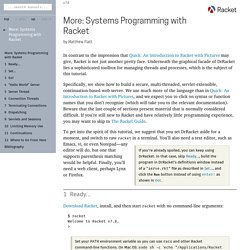
Underneath the graphical facade of DrRacket lies a sophisticated toolbox for managing threads and processes, which is the subject of this tutorial. Specifically, we show how to build a secure, multi-threaded, servlet-extensible, continuation-based web server. To get into the spirit of this tutorial, we suggest that you set DrRacket aside for a moment, and switch to raw racket in a terminal. 1 Ready... Link to this section with @secref["ready" #:doc '(lib "scribblings/more/more.scrbl")] Download Racket, install, and then start racket with no command-line arguments: Set your PATH environment variable so you can use raco and other Racket command-line functions.
:SPARQL query service/A gentle introduction to the Wikidata Query Service. A gentle introduction to the Wikidata Query Service[edit] Have you ever wondered about questions like these?
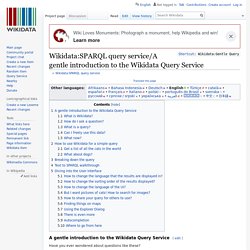
What are the largest cities in the world that have a female mayor?
John Horton Conway, a ‘Magical Genius’ in Math, Dies at 82. Dr.
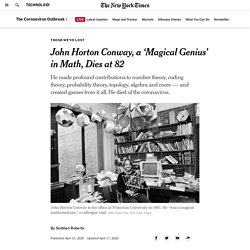
Conway’s mother, a great reader, especially of Dickens, had worked from age 11. Family lore has it that she boasted about finding her son at age of 4 reciting the powers of two. At 18, in 1956, John left home for the University of Cambridge, where he earned his Ph.D. His adviser, Harold Davenport, a number theorist, once said that when he would give Dr. Conway a problem to solve, “he would return with a very good solution to another problem.” As a student, Dr.
Scheme.forth.jl: Scheme in Forth in Julia. Interlisp family — Software Preservation Group. L.
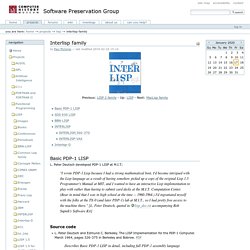
Peter Deutsch developed PDP-1 LISP at M.I.T.: The first LISP at Bolt Beranek and Newman Inc. was influenced by L. Peter Deutsch's Basic PDP-1 LISP: "... my PDP-1 Lisp implementation, as you probably know, was extensively rewritten at BB&N to become the conceptual predecessor of BBN-Lisp, which in turn engendered Interlisp" [L. .
`. . . one of the things we did was build a timesharing LISP system on the PDP-1 — that is, a multi-user system for which the primary (and only) interface language was LISP.
Zebra Puzzle. The zebra puzzle is a well-known logic puzzle.
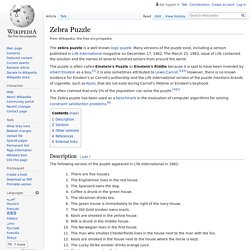
Many versions of the puzzle exist, including a version published in Life International magazine on December 17, 1962. The March 25, 1963, issue of Life contained the solution and the names of several hundred solvers from around the world. It is often claimed that only 2% of the population can solve the puzzle.[4][5] Description[edit] The following version of the puzzle appeared in Life International in 1962: Solution[edit] Assuming that one person drinks water and one owns a zebra, then it is possible not only to deduce the answers to the two questions, but to figure out a complete solution of who lives where, in what color house, keeping what pet, drinking what drink, and smoking what brand of cigarettes. Note that clue 10 mentions the "first" house, without specifying whether it is the house on the extreme left or extreme right if standing in front of them.
Other versions[edit] References[edit] ^ Stangroom, Jeremy (2009). External links[edit]
Over 200 of the Best Machine Learning, NLP, and Python Tutorials - 2018 Edition. The article contains the best tutorial content that I’ve found so far.
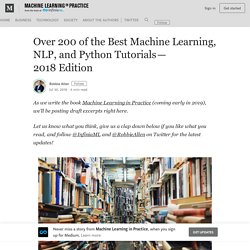
It’s by no means an exhaustive list of every ML-related tutorial on the web — that would be overwhelming and duplicative. Plus, there is a bunch of mediocre content out there. My goal was to link to the best tutorials I found on the important subtopics within machine learning and NLP.
FRAMESA Framework for Representing Knowledge Marvin Minsky MIT-AI Laboratory Memo 306, June, 1974.
It seems to me that the ingredients of most theories both in Artificial Intelligence and in Psychology have been on the whole too minute, local, and unstructured to account–either practically or phenomenologically–for the effectiveness of common-sense thought.
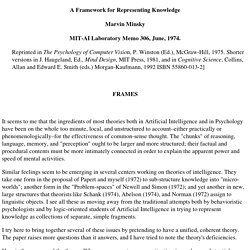
The "chunks" of reasoning, language, memory, and "perception" ought to be larger and more structured; their factual and procedural contents must be more intimately connected in order to explain the apparent power and speed of mental activities. Similar feelings seem to be emerging in several centers working on theories of intelligence. They take one form in the proposal of Papert and myself (1972) to sub-structure knowledge into "micro-worlds"; another form in the "Problem-spaces" of Newell and Simon (1972); and yet another in new, large structures that theorists like Schank (1974), Abelson (1974), and Norman (1972) assign to linguistic objects.
Programs With Common Sense - John McCarthy mcc59. Harvard CS 50 Week one class transcript link.







